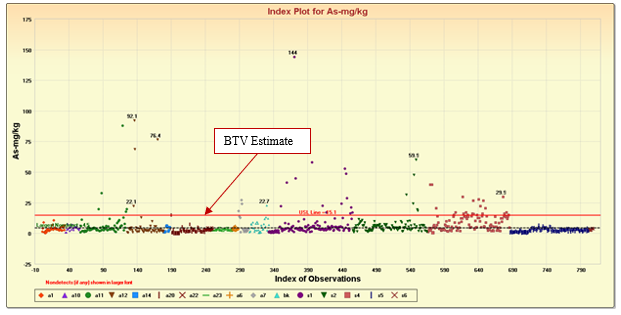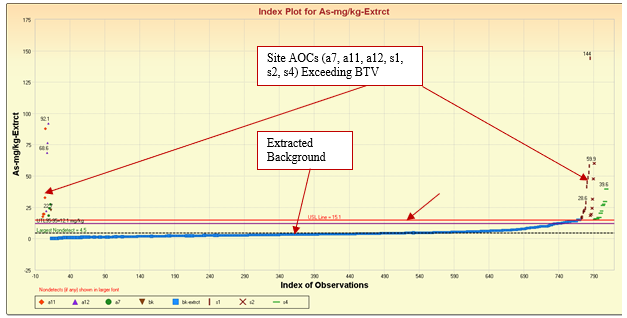Appendix B. Index Plots
An index plot based upon a dataset, x1, x2, …, xn of size n represents a scatter plot obtained by plotting n pairs. An index plot represents a visual way of identifying intermediate and extreme outliers potentially present in a mixture on-site dataset. The data values need not be ordered in any way. The generation of index plots does not require any distributional assumptions and the availability of spatial data (x, y coordinates; latitude and longitude) associated with sampled locations. Since an index plot represents a scatter plot, any software equipped to generate a scatter plot can be used to generate an index plot.
For clarity and usefulness of an index plot, one may want to order data by their population identification (ID) codes (for example, AOC1, AOC2…) (where AOC=area of concern) in the generation of an index plot as shown in Figure B1. On an index plot, observations from the various groups, including AOCs and an extracted background (for example, labeled as bk-extrct) data, are color-coded, where different colors represent different groups (AOCs). To avoid the distortion of the scale of an index plot, ND observations with elevated detection limits (DLs) may not be displayed on the index plot. An index plot can be formalized by drawing horizontal lines at one or more BTV estimates (for example, USL95, UTL 95-95), or at a prespecified regional cleanup level meant to compare individual on-site concentrations. The use of such index plots (Figures B1 and B2) comparing background (original or extracted) and the remaining on-site data (not included in extracted background data) may help the site managers in quickly identifying site AOCs and in making cleanup and remediation decisions at those AOCs.
Figure B1 contains a color-coded index plot of the surface soil arsenic (prior to background extraction) dataset used in Section 3.9.5. It exhibits data of the AOCs and the existing background (labeled as bk) with a horizontal line displayed at a BTV estimate. Figure B2 has the similar index plot comparing the extracted background dataset (shown in blue) to the remaining contaminated AOCs concentrations.

Horizontal line displayed at the BTV estimate =15.1 mg/kg.
Figure B1. Index plot comparing surface soil arsenic concentrations of the existing background (bk) and various AOCs (prior to background extraction).
Source: Anita Singh, ADI-NV Inc.

Horizontal lines displayed at the BTV estimate, 15.1 mg/kg, and the largest nondetect value, 4.5 mg/kg.
Figure B2. Index plot comparing surface soil arsenic concentrations of the extracted background (bk-extrct) and the remaining AOCs (not included in bk-extrct).
Source: Anita Singh, ADI-NV Inc.


